#Cretan Resistance
Explore tagged Tumblr posts
Note
Just listened to Marina Sattis performance of "Stis Naousas to kastro", which as far as I understand is about a mass suicide of Greek women and children to escape the Turks. How many songs like these are there in Greek tradition? I know of "Dance of Zalongo", were such suicides common in Greek history?
Greeks hold their dignity and honor very high. Greece is one of the most conquered nations in history, and sadly there were many tragic moments like this from antiquity to more modern times. People of all ages preferred to take their own lives, rather than get dishonored through violence, rape, and forceful assimilation.

"Episode of the siege of Messolonghi" (1827), Francois-Έmile de Lansac
For the ancient years: Mass Suicide of the Women of Melos, the conquest of the Greek city of Miletos by the Persians, the women of Troezen preparing for mass suicide, the women of Argos, of Kassandreia, Euboea, of Torone in Chalcidice , Heraclea Pontica, of Aegina... So many cases! For the latter years I saw the cases of The siege of Mystras, the siege of Constantinople, the Fall of Corinth to the Ottomans were more of such cases when we speak of more recent centuries.
Some from the Ottoman times, summarized briefly:
The Arkadi Monastery (1866) During the Cretan Revolt against Ottoman rule, hundreds of Greeks, including many women and children, sought refuge in the Arkadi Monastery. When it became clear that they would be overrun, the refugees detonated barrels of gunpowder, taking their own lives to avoid surrender. This act of self-sacrifice became a powerful symbol of Cretan resistance.
Mass Suicides of Chios (1822) Following the brutal massacre of the Greek population of Chios by Ottoman forces, some inhabitants, particularly women and children, chose suicide over enslavement. Many took to the cliffs to escape capture, throwing themselves to their deaths in a final act of defiance.
The Exodus of Missolonghi (1826) During the long siege of Missolonghi, residents suffered starvation and deprivation at the hands of Ottoman forces. When defeat became inevitable, many women, children, and elderly people took their lives rather than fall into enemy hands. This exodus marked one of the most somber moments of the Greek War of Independence.
Sadly, I don't know the individual songs. I reckon they could be a dozen or even hundreds, since each village has its own songs here, and its own times of resistance.
27 notes
·
View notes
Text


Miss Grand Greece 2023
"Sfakiani costume" The Sfakiani costume originates in Western Crete - Hora Sfakion. Hora Sfakion is famous as one of the centers of resistance against the occupying forces of both the Venetians and the Turks. The impenetrable White Mountains to the north combined with the rocky beaches on the south helped the locals fight off all invaders.The woman's costume is a representation of the graceful, proud women of Crete, who are modest but yet strong and powerful! The vest is hand embroidered with traditional designs rooted in Cretan history and nature, like the tree of life and the spiral(speira). The skirt is made of brocade!
73 notes
·
View notes
Text
‘Pimpernel of the Hellenes’, ‘Major Paddy’, ‘Enchanted maniac’: Will the real Paddy Leigh Fermor please stand up?
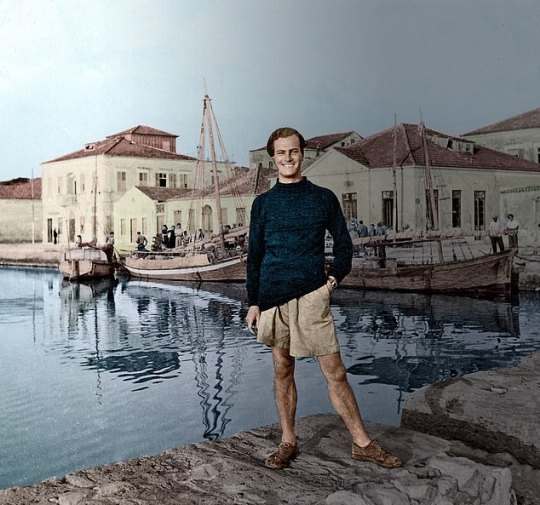
Paradox reconciles all contradictions. - Patrick Leigh Fermor
So one evening I was baby sitting my nephews and nieces here in our family chalet in Verbier, high up in the Swiss Alps. It was my turn to baby sit as the rest of my family enjoyed the fantastic classical music concerts and events showcased at the two week long Verbier 30th Festival. The little scamps had gone to bed and my father and I watched an old British war movie on DVD, ‘Ill Met By Moonlight’ (1957). It was filmed by the legendary team of Michael Powell and Emeric Pressburger based on the 1950 book ‘Ill Met by Moonlight: The Abduction of General Kreipe’ by W. Stanley Moss.
I’ve seen the film a couple of times before, but until now never really paid attention to where the title came from. My father said it was from Shakespeare’s ‘A Midsummer’s Night’s Dream’ And so it was. In the play, Oberon, the king of the fairies and the Queen are having a fairly bitter drawn-out fight over custody of a changeling Indian child, and this is how the pissed off king greets the queen when they run into each other, “Ill met by moonlight, proud Titania”. Oberon is basically saying "Oh Lord, it's you..." and Titania's response is basically a flippant middle finger. One of the best modern reasons to read Shakespeare: to throw playful erudite shade at others.
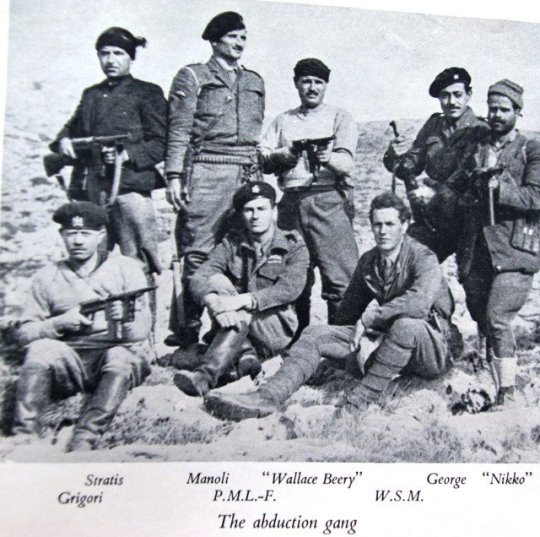
Anyway, the historical background of the film is the German invasion of Crete in May 1941. After an intense ten-day battle, Allied troops were driven back across the island, and many were evacuated from beaches along the southern coast. Some Cretans and British officers took to the mountains to organise resistance against the occupying forces. The German occupation that followed was especially brutal. Dreadful reprisals followed every act of resistance. The German commander, General Müller, insisted on taking 50 Cretan lives for every German soldier killed; he became known as ‘The Butcher of Crete’.
As a Classicist side note, there had been a close association between Britain and Crete since the early 20th century, when archaeologist Sir Arthur Evans had uncovered the sensational remains of a Minoan palace at Knossos. The headquarters of the British archaeological school in Crete was a large villa alongside the site, known as Villa Ariadne. Several archaeologists, who knew the island and its people well, went underground after the German occupation to aid the Cretan resistance. Continuing in this tradition, scholar and travel-writer Patrick Leigh Fermor, who had got to know Greece in the 1930s, joined the Special Operations Executive (SOE).
During the German occupation, Major Paddy Leigh Fermor travelled to Crete three times to help organise local resistance against the hated German occupation. On the third occasion, in February 1944, he was parachuted in with a specific mission to kidnap German commander General Müller, to boost morale on Crete along with his erstwhile SOE comrade Capt. W. Stanley Moss MC (aka Billy Moss) of the Coldstream Guards. However, just after they parachute in, General Müller was replaced by General Heinrich Kreipe, who transferred from the Russian Front. Thinking that capturing one general was as good as another, Fermor merrily go ahead with the daring kidnap operation.
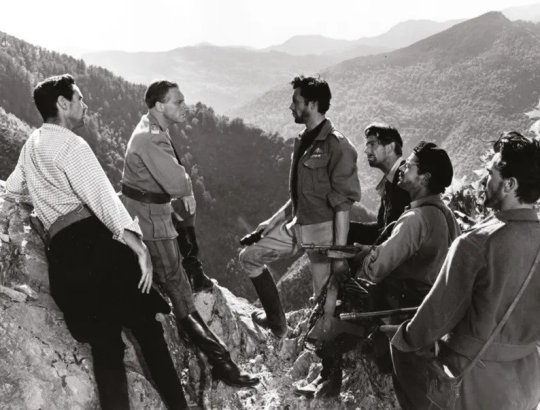
It’s at this point that the narrative of Michael Powell and Emeric Pressburger’s ‘Ill Met by Moonlight’ (1957) picks up. Dirk Bogarde plays Paddy Leigh Fermor, David Oxley plays Moss, and Marius Goring plays the taciturn German paratroop general. Blink and you’ll miss the late great Christopher Lee making a cameo appearance as a German officer in the dentist’s room scene.
The film naturally takes some liberty with the facts but it’s a cracking yarn of high adventure and drama. Xan Fielding, a close friend of Leigh Fermor from the SOE in Cairo, was taken on as technical adviser. The fact the film was shot in in the Alpes-Maritimes in France and Italy, and on the Côte d'Azur in France, far away from the craggy valleys and mountains of Crete itself. The director Michael Powell spent some time walking in Crete to get to know the island, but decided that, with the confused and volatile state of Greek politics, it was not suitable to film there.
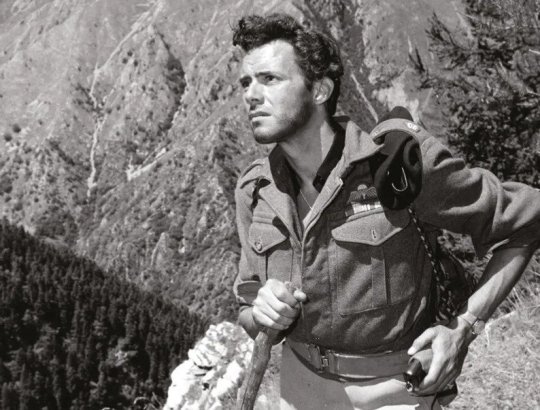
Looking back years after he had directed it Powell didn’t think much of his own film. By contrast, Paddy Leigh Fermor, who was on set throughout the film shoot, was very happy with Bogarde’s portrayal of him with Byronic glamour. Watching the movie again ‘Ill Met by Moonlight’ remains a classic and stands out from many British war films of the 1950s because of its realism. The British SOE men and the Cretan guerrillas look absolutely right for their parts. It is dramatic and full of suspense while filled with much boyish humour.
I was disappointed with one notable omission in the film that did happen in real life. According to Patrick Leigh Fermor, at dawn one day during the journey across the mountains, General Kreipe was looking at the mist rising from Mount Ida and began to recite, in Latin, the opening lines of Horace’s ninth ode:
Vides ut alta stet nive candidum Soracte nec iam sustineant onus silvae laborantes geluque flumina constiterint acuto?
Behold yon Mountains hoary height, Made higher with new Mounts of Snow; Again behold the Winters weight Oppress the lab’ring Woods below: And Streams, with Icy fetters bound, Benum’d and crampt to solid Ground
(John Dryden 1685)
Leigh Fermor picked up on the General, and recited the remaining stanzas of the Ode. ‘Ach so, Herr Major,’ said Kreipe when Leigh Fermor had finished. Both men were amazed to realise they shared a classical education and a love of ancient Latin poetry.
Leigh Fermor later wrote that it was as though the war had ceased to exist for a moment, as ‘We had both drunk from the same fountains before.’ It brought captor and captive together with a strange bond. The scene was not reproduced in the film, as Powell and Pressburger probably thought it would make the men sound too academic for a popular cinema audience.
Leigh Fermor and Kreipe met again in the early 1970s, on a Greek television show, and got on famously together. The General said Leigh Fermor had treated him chivalrously as a captive. They remained friends until Kreipe’s death.

After sharing a late night drink with my father after the film, I began to muse on the figure of Paddy Leigh Fermor, a family friend and someone I met along with his wife, Joan, as a little girl. My grandparents, and especially my grandmother, knew Paddy briefly from their days during and after the Second World War.
My father shared a few stories about him when he and my mother visited his beautiful home in Greece, where even at his advanced age he remained the most generous of hosts and the most outrageous flirt.
One of my memories was getting into his battered old Peugeot in the drive way and trying to drive it when my feet could barely touch the pedals. It wouldn’t have mattered in any case as the brakes didn’t work as he cheerfully said later as we careened around a dirt road to go around the mountains for a drive.
Many years later in April 2022, I tried to visit the home of the late Patrick and Joan Leigh Fermor - a sort of pristine shrine to their memory that one can also stay in any of the rooms as a vacation rental - in the coastal fishing village of Kadarmyli in the Peloponnese, as part of a hiking and mountaineering sojourn around Greece with ex-Army friends. We couldn’t stay there as it was already rented out to other guests, and so we stayed higher up the mountain in a villa, but we swam in front of the Fermor’s home which was on the water’s edge.
You could never put your finger on Paddy Leigh Fermor. He hid behind his gift for telling yarns, and pulling Ancient Greek verses out of the thin air, as well as boisterously singing local Greek songs with a drink in his hand.
Even after his death in 2011, the question keeps nagging as to who was Paddy Leigh Fermor?
The Dirk Bogarde film too seems to ask, who exactly is the ‘real’ Patrick Leigh Fermor - or the real anyone? Taking its title from a Shakespearian play concerned with dreams and disguises, magic and power, ‘Ill Met By Moonlight’ is all about questions of identity.
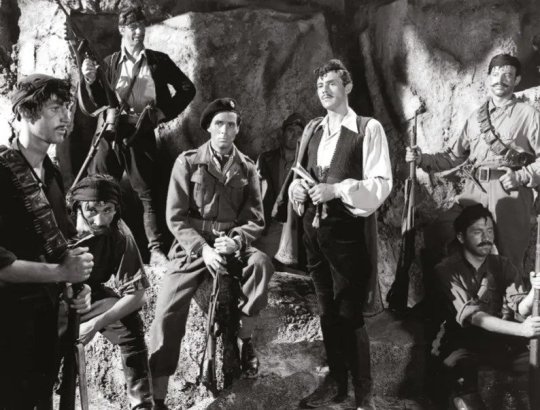
Under the film credits, we see Dirk Bogarde in uniform; then, unexpectedly, we see him in the flamboyant outfit of a Cretan hill-bandit. A title informs us that Major Leigh Fermor was also known by the Greek code-name “Philidem.” In other words, there are two of him (at least), and on one level the adventure the film is about to unfold reflects a conflict in his personality. It’s a conflict shared, unknowingly, by his Nazi opposite number, the fierce, arrogant General Kreipe (an unlikely “proud Titania,” but it’s true that he “with a monster is in love” – the monster of Nazism). Kreipe’s human side is so rigorously repressed by the demands of war and “glory” that he is genuinely unaware of it; ironically, this humanness, which constitutes the true manhood of this Teuton warrior, is revealed by a boy (equivalent to Shakespeare’s Indian Prince?) - who, in turn, is the most grown up person in the movie.
If “Philidem” appears under the credits, caped and open-shirted, a romantic dream-figure out of an operetta or a storybook, he is first seen in the film proper as a coarser, more down-to-earth version of the same thing – an ordinary Cretan peasant in a shabby suit, waiting for a bus. When he makes contact with the Resistance, his personality fragments further.
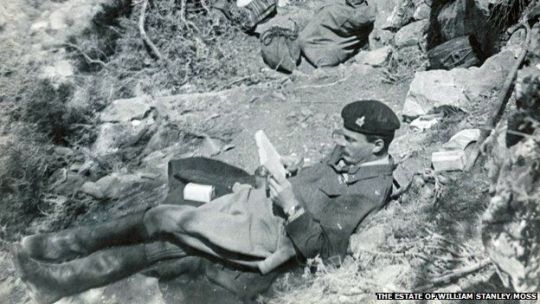
To some, he is the mystical Philidem, Pimpernel of the Hellenes and righter of wrongs. To others he is “Major Paddy,” the happy-go-lucky Englishman of popular movie myth conducting war as if it were a branch of amateur theatricals, a gentleman adventurer relying on breeding to get him through and making fun of the whole business. To Bill Moss (David Oxley), the newly arrived junior officer sent to assist him, he is the cool, fast-thinking professional soldier. And to himself? In his quietly passionate defence of Cretan life and culture, he seems someone else again: a scholar and aesthete outraged by the barbarism and folly of war, and by the moronic arrogance shown by his captive toward the Cretan people.
Whatever his persona, Leigh Fermor is a chameleon who never seems to change very radically in himself. Perhaps because he has this quality of seeming all things to all men – and being those things - he remains unfazed by the monolithic might of the German military machine. Fluent in Greek, he can also speak German like a German and is easily able to assume another disguise, that of a faceless Nazi officer. Although he and Moss make fun of themselves - “If only I had a monocle!” muses Moss when Leigh Fermor tells him he “looks like an Englishman dressed like a German, leaning against the Ritz bar” - they are able to effect the kidnapping with an ease that seems appropriately Puckish. General Kreipe is ignominiously thrust onto the floor of his own limousine, gagged, and sat upon by a couple of the peasants he so despises. Kreipe’s rage is compounded by his firm conviction that he has been snatched by “amateurs” - a belief Leigh Fermor and Moss slyly make no objection to, knowing how it will gnaw at his already shaky Master Race self-confidence.
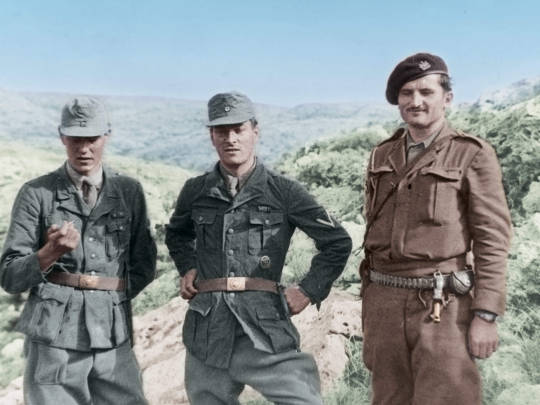
Patrick Leigh Fermor, aka Major Paddy, aka Philidem, in the film’s closing moments, is far from being self-assured intellectual or dashing amateur adventurer or legendary outlaw of the hills. He’s just a tired man who wants to go home and rest up. “How do you feel?” asks Moss. “Flat” is the reply. “You look flat!” says Moss. “I know how I’d like to look …” murmurs Leigh-Fermor wistfully. Moss knows what he’s going to say, and joins in the litany: “Like an Englishman dressed like an Englishman – and leaning against the Ritz bar!” It’s easy to imagine them ordering drinks at that renowned watering-hole with all the suavity required by this little fantasy.
Still, the film’s last images of Crete receding in the distance, until all we can see is the sea, suggests that maybe Major Paddy’s heart is really back in those hills in the “fair and fertile” land that has become as much a Powellian landscape of the mind for us as the studio-built Himalayan convent of ‘Black Narcissus’ or the monochrome Heaven of ‘A Matter of Life and Death’. And, as the film POV closing shots departs both Crete and this film, I began to think that being “dressed like an Englishman and leaning against the Ritz bar” would, for Patrick Leigh Fermor constitute yet another disguise. After all, he said he was of Irish aristocratic stock.
Traveller and writer Paddy Leigh Fermor is best known for two events. He’s known for leading the commando group in occupied Crete to kidnap General Kreipe. But he is also known for the boy who, at a mere 18 years old, set off with little money and a lot of nerve in 1933 to walk from the Hook of Holland to Constantinople.
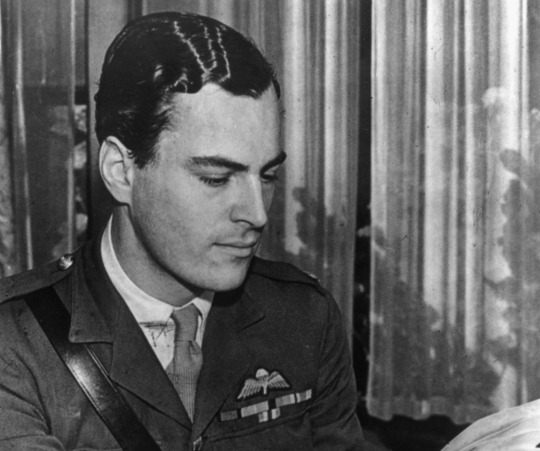
Patrick Leigh Fermor was, in the words of one of his obituaries, a cross between Indiana Jones, James Bond and Graham Greene. Self-reliance and derring-do were lessons learnt from the cradle. When Fermor’s geologist father was posted to India, he and his wife left the infant with family in Northamptonshire and did not return until his fourth birthday. In retrospect, he took great delight in being sent to a school for difficult children and getting himself expelled from the King’s School, Canterbury, when he was caught holding hands with a greengrocer’s daughter eight years his senior. His school report infamously judged him ‘a dangerous mix of sophistication and recklessness’.
Sharing a flat in Shepherd’s Market, one of Mayfair’s seedier corners, Leigh Fermor schooled himself in literature, history, Latin and Greek.
He honed his character with the company of extraordinary people and the words of great writers - he had a prodigious memory for prose as well as poetry. He befriended literary lions such as Sacheverell Sitwell, Evelyn Waugh and Nancy Mitford. His travels began aged ‘eighteen-and-three-quarters’ when he rejected Sandhurst Royal Military College in order to walk the length of Europe from Hook of Holland to Constantinople. He took with him Horace’s Odes and the Oxford Book of Verse though Leigh Fermor could recite Shakespeare soliloquies, Marlowe speeches, Keats’s Odes and as he modestly put it ‘the usual pieces of Tennyson, Browning and Coleridge’ from memory.
Leigh Fermor was then a self-made man in the most literal sense.

Setting off from England in 1933, Fermor resolved to traverse Europe living like a hermit; sleeping in bars and begging for food. But his manly charms and boyish good looks found him being passed like a favourite godson from Schloss to palace by European nobility and he developed a lifelong penchant for aristocratic company. I his own words, ‘In Hungary, I borrowed a horse, then plunged into Transylvania; from Romania on into Bulgaria’. Having reached Constantinople in January 1935, Fermor continued to explore Greece where he fought on the royalist side in Macedonia quelling a republican revolution. In Athens Leigh Fermor met Balasha Cantacuzene, a Romanian countess with whom he fell in love. They were living together in a Moldovan castle when World War Two was declared.
Fluent in Greek, Leigh Fermor was posted as a liaison officer in Albania. Recruited as a Special Operations Executive (SOE), he was shipped from Cairo to German-occupied Crete where he lived disguised as a shepherd in the mountains for two years. On his third expedition to Crete in 1944, Leigh Fermor was parachuted alone onto the island and made connections in the Cretan resistance movement. While waiting for his compatriot Captain Bill Stanley Moss to land by water from Cairo, Leigh Fermor hatched a plot to kidnap German Commander General Heinrich Krieple. He liaised comfortably with Cretan partisans and bandits to pull off one of the war’s greatest coups de théâtre.
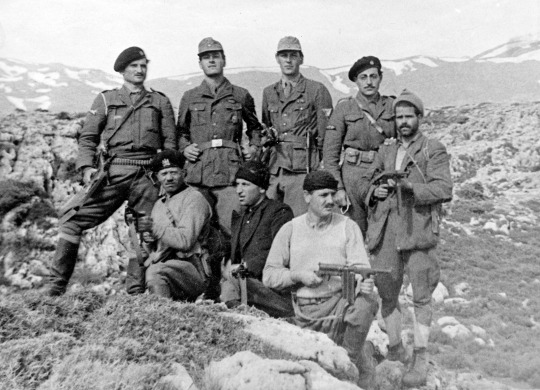
Disguised as German soldiers, Leigh Fermor and Moss stopped Krieple’s car at an improvised check point en route back to Nazi HQ in Knossos. Abandoning the General’s car after a two-hour drive, Leigh Fermor left a note indicating that the kidnappers were British so that there wouldn’t be reprisals against Cretan nationals. When the abduction of the unpopular commander was discovered, a German officer in Heraklion allegedly said ‘well, gentlemen, I think this calls for champagne’. It turns out that General Kreipe was despised by his own soldiers because, amongst other things, he objected to the stopping of his own vehicle for checking in compliance with his commands concerning approved travel orders. It’s why for instance the German troops, both in the film and in real life, dare not stop the General’s car as it drove through the check points at Heraklion.
Krieple was evacuated and taken to Cairo and Leigh Fermor entered the annals of World War Two’s most devil-may-care heroes. With characteristic panache, when he was demobbed Leigh Fermor moved into an attic room at the Ritz paying half a guinea a night. But his first travel book, ‘The Traveller’s Tree’, was not about the European odyssey or the Cretan escapades and centred on Leigh Fermor’s adventures in the Carribbean. Published in 1950, ‘The Traveller’s Tree’ was an inspiration for Ian Fleming’s second James Bond novel ‘Live and Let Die’ (1954).
As a host and house guest, Paddy Leigh Fermor was much sought-after. At one of his parties in Cairo, he counted nine crowned heads. He was a confirmed two-gin-and-tonics before lunch man and smoked eighty to 100 cigarettes a day. His party pieces included singing ‘It’s a Long Way to Tipperary’ in Hindustani and reciting ‘The Walrus and the Carpenter’ backwards. In Cyprus while staying with Laurence Durrell, Leigh Fermor apparently stunned crowds in Bella Pais into silence by singing folk songs in perfect Cretan dialect. As Durrell wrote in ‘Bitter Lemons’ (1957), ‘it is as if they want to embrace Paddy wherever he goes’.
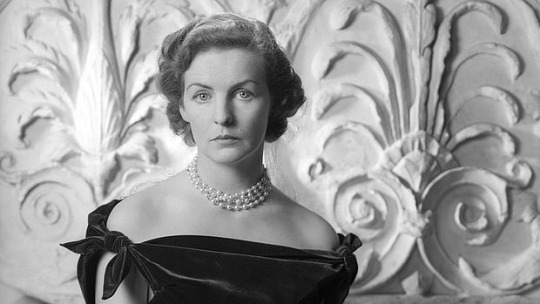
He struck up a partiuclar friendship with the famous Mitford sisters, especially Deborah Mitford, later ‘Debo’, the Duchess of Devonshire. It was at the Devonshires’ Irish estate Lismore Castle that ‘Darling Debo’ and ‘Darling Pad’ met and began to correspond. A characteristic letter from the Duchess in 1962 reads ‘The dear old President (JFK) phoned the other day. First question was ‘Who’ve you got with you, Paddy?” He’s got you on the brain’ to which Fermor replies of a broken wrist ‘Balinese dancing’s out, for a start; so, should I ever succeed to a throne, is holding an orb. The other drawbacks will surface with time’.
After the war he travelled widely but was always drawn back to Greece. He built a house on the Mani peninsula - which had been, significantly, the only part of Magna Graecia to resist Ottoman colonisation since the fall of Constantinople in 1453. Before his death in 2011 at the age of 96, he wrote some of the most acclaimed travel books of the 20th century.
His books contain some of the finest prose writing of the past century and disprove Wilde's maxim that "it is better to have a permanent income than to be fascinating".
Charm, self-taught knowledge and enthusiasm made up for the lack of a university degree or a private income. His teenage walk across Europe and subsequent romantic sojourn in Baleni, Romania, with Princess Balasha Cantacuzene are proof enough of that. But the difficulty of capturing such an unconventional and glamorous life is made harder by the certainty that Fermor was an unreliable narrator.
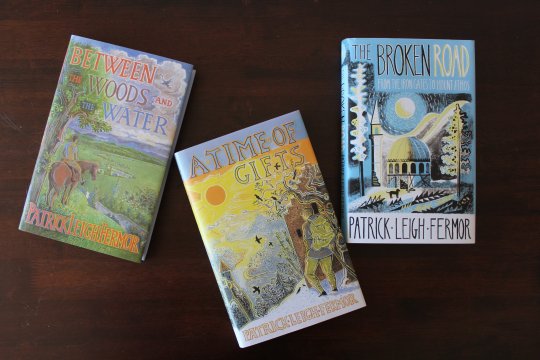
He was also an infuriatingly slow writer. Driven by a life-long passion for words yet hampered by anxiety about his abilities, Leigh Fermor published eight books over 41 years.
‘The Traveller's Tree’ describes his postwar journey through the Caribbean; ‘Mani‘ and ‘Roumeli’ (1958 and 1966) draw on his experiences in Greece, where he would live for much of the latter part of his life. But it is the books that came out of his trans-Europe walk that reveal both the brilliance and the flaws. ‘A Time of Gifts’ was published in 1977, 44 years after he set out on the journey. ‘Between the Woods and the Water’ appeared nine years later. Both describe a world of privilege and poverty, communism and the rising tide of Nazism, and end with the unequivocal words, "To be continued". Yet the third volume hung like an albatross around the author's neck. As the years passed, Fermor found it impossible to shape the last part of his story in the way he wanted.
Leigh Fermor was that rarest of men: a man determined to live on his own terms, if not his own means, and who mostly - and mostly magnificently - succeeded. Always popping off on a journey when he should have been writing about the last one, always ready to party, he was forever chasing beautiful, fascinating or powerful women, even when with his wife, Joan Raynor. She was the great facilitator who funded his passion for travel and writing, as well as women, from her trust fund. His love affairs were discreet but legendary.
Leigh Fermor was happiest among the rogues. Over a lifetime on the road, he sought them, and in turn they responded to his charm, nose for adventure, and his famous wit. He was a keenly-anticipated dinner guest - once outshining Richard Burton at a London society soirée, who he cut-off midway through a recital of ‘Hamlet’. As Richard Burton stormed out, the pleading society hostess said, “But Paddy’s a war hero!” to which Burton grouchily replied, “I don’t give a damn who he is!”
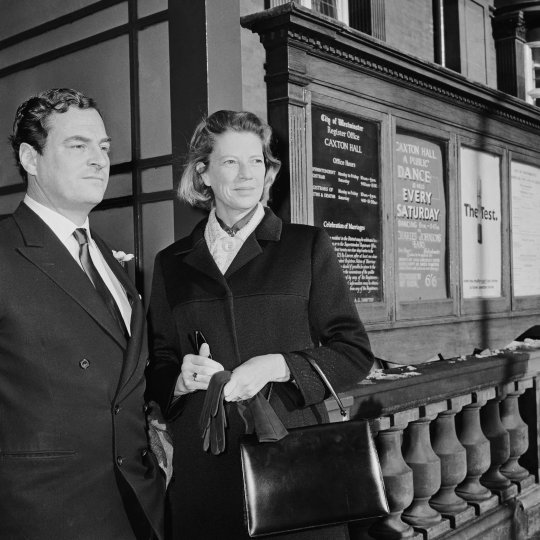
His partnership with and then marriage to Joan Raynor was an open relationship, at least on Leigh Fermor’s side. Paddy saw in Joan his kindred spirit. Like him, she spent much of her youth travelling to where she pleased; largely in France, where the photographer and literary critic Cyril Connolly became besotted by her. Joan was the daughter of Sir Bolton and Lady Eyres Monsell of Dumbleton Hall, Worcestershire. She was not only stunningly pretty but also 'a beautiful ideal, with the perfect bathing dress, the most lovely face, the most elaborate evening dress', as the Eton educated Connolly described her. Joan also stood out from the upper-class beauties of her day in that she supplemented her mean rich father's allowance by earning her living as a decent photographer.
In 1946, she met Leigh Fermor in Athens, while he was deputy director of the British Institute. Joan met him at a time when he was then in a relationship with a French woman called Denise, who was pregnant with his child, which she aborted. The pair would travel to the Caribbean together under the invitation of Greek photographer Costas, falling madly in love.

She was the only woman that - after decades of sexual scandals - matched his own erratic behaviour. Stories of how they dined fully-clothed in the Mediterranean, dragging a table into the sea, as well as their myriad cats and olive groves, paint a restless couple, who, when not out articulating the peoples of their adopted homeland, kept themselves very busy.
The attraction between Paddy and Joan was instant. So many love affairs that Paddy indulged in seemed about as brief as the flame from a burning envelope and you expected this one with Joan to be too. But somehow, miraculously, it lasts.
The two were apart a great deal, but in their case, absence did make the heart grow fonder. While Paddy was staying in a monastery in Normandy, supposed to be thinking monk-like thoughts that he would eventually put into his masterpiece A Time To Keep Silence, he was also writing sexy letters to Joan: 'At this distance you seem about as nearly perfect a human being as can be, my darling little wretch, so it's about time I was brought to my senses.' And: 'Don't run away with anyone or I'll come and cut your bloody throat.'
She tantalised him with descriptions of Cyril Connolly making passes at her; but she, like Denise, sounded a rather desperate note when she wrote: 'I got the curse so late this month I began to hope I was having a baby and that you would have to make it a legitimate little Fermor. All hopes ruined this morning.'
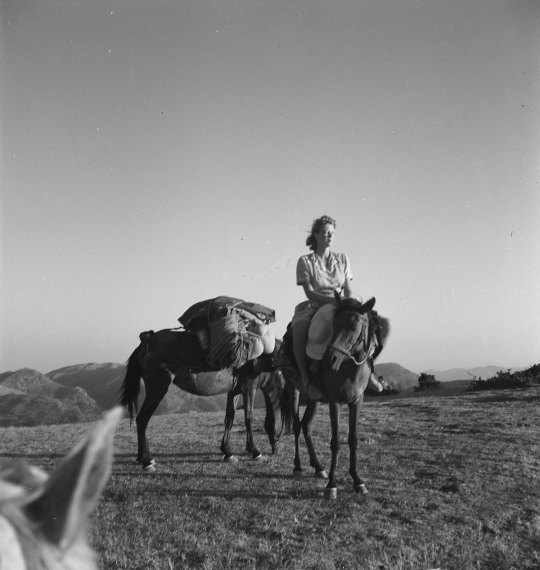
Fiercely independent - a trait that must have enamoured Paddy - they were best imagined as two pillars of a Greek temple, beside one-another but capable of holding up the roof of the world that they had built for themselves through the lens of ancient history and Hellenic culture. Indeed, it was said that they had a special ‘pact of liberty’. It is this unconquerable aura that led poet laureate John Betjeman to declare his love for her (he called her ‘Dotty’ and remarked that her eyes were as large as tennis balls). For Cyril Connolly, the photographer she shadowed, and with whom she had a scandalised affair during her first marriage, she was a “lovely boy-girl” and Laurence Durrell named her the ‘Corn Goddess’ because of her slender figure and short hair. But of all of these worthy candidates, it was the warrior-poet Patrick Leigh Fermor who finally won her heart.
To Joan, who described herself as a ‘lifelong loner’ in her diaries, her companionship with the uncomplicated Paddy was a relief. They had no children, nor did they want any - or so Paddy claimed. But those who knew Joan suspected she did want children but it never came to pass; and so she became a devoted aunt or dotted on other friends’ children. For both of them their dozens of cats gave them the next best thing to paternal satisfaction. Still, her morbid fascination with photographing cemeteries painted a much darker side.
Joan Raynor’s inheritance subsidised his peripatetic life at least until the enormous success of ‘A Time of Gifts’ in the late 1970s, which in turn created a new market for his previous volumes about Greece, ‘Mani’ and ‘Roumeli’.

With Joan’s tacit consent, Paddy enjoyed amorous flings, discrete sexual affairs with high society women and sampled the low delights of the brothel. This activity rarely made it into his private letters, but the exceptions could be piquant. Writing in 1958 from Cameroon, where he was on the set of a John Huston movie, he told a (male) friend: “ Errol Flynn and I . . . sally forth into dark lanes of the town together on guilty excursions that remind me rather of old Greek days with you.” In a 1961 letter to the film director John Huston’s wife, Ricki, with whom Leigh Fermor had been having sex with (and would die in a car crash in 1969). “I say,” the passage begins, “what gloomy tidings about the CRABS! Could it be me?” Riffing on pubic lice and their crafty ways, he conjectures that, during a recent romp with an “old pal” in Paris, a force “must have landed” on him “and then lain up, seeing me merely as a stepping stone or a springboard to better things” - to Mrs. Huston, that is. As comic apologies for venereal infection go, the passage is surely a classic.
Like most high flying lives, it was far from blameless. Wounded women were littered in his wake. Some British visitors to Athens were less than impressed by this Englishman who posed as “more Greek than the Greeks”.
Some Greeks shared their disdain. Revisionist historians criticised his role in wartime Crete, and warned their fellow Hellenes that for all his fluency and charm, Leigh Fermor was no latter day Byron. His unoccupied car was blown up outside his Mani house, probably by members of the Greek Communist Party which he had vocally opposed. The accidental fatal shooting of a partisan in Crete led to a long blood feud which made it difficult for Leigh Fermor to re-enter the island until the 1970s, and possibly explains why he chose to settle in the Peloponnese rather than among the hills and harbours of his dreams.
His own books had already eclipsed those incidents, not only among readers of English but also in Greece, where in 2007 the government of his adopted land made him a Commander of the Order of the Phoenix for services to literature.
Travel writers such as the great Jan Morris have described Leigh Fermor as the master of their trade and its greatest exponent in the 20th century.

When ‘A Time of Gifts’ was published in 1977, Frederick Raphael wrote: “One feels he could not cross Oxford Street in less than two volumes; but then what volumes they would be!”
They are not for everyone. Leigh Fermor wrote that written English is a language whose Latinates need pegging down with simple Anglo-Saxonisms, and some feel that he personally could have made more and better use of the mallet. His exuberance is either captivating or florid. It is certainly unique among English prose styles.
Artemis Cooper, his patient and careful biographer wrote that “Paddy had found a way of writing that could deploy a lifetime’s reading and experience, while never losing sight of his ebullient, well-meaning and occasionally clumsy 18-year-old self … this was a wonderful way of disarming his readers, who would then be willing to follow him into the wildest fantasies and digressions”.
Those fantasies and digressions took decades to express. ‘A Time of Gifts’ had arguably been 40 years in the making when it was published in 1977. Its sequel, ‘Between the Woods and the Water’, did not appear until 1986. The third and final volume has been awaited ever since. Following Leigh Fermor’s death, a foot-high manuscript was apparently found on his desk.
Once he knuckled down to it, Leigh Fermor loved playing around with words. He was one of our greatest stylists and he was devoted to producing un-improvable books. But writing did not come easily to him, at least partly because it was something of a distraction from the main event, which was living an un-improvable life of unrepentant gaiety and fun.
For forty odd years, a legion of friends and admirers would beat a path to Paddy and Joan’s door. Artists, poets, royalty and writers came, all taking inspiration from their erudite hosts. A visit was an act of communion, a sharing of ideas and stories.
Leigh Fermor influenced a generation of British travel writers, including Bruce Chatwin, Colin Thubron, Philip Marsden, Nicholas Crane, Rory Stewart, and William Dalrymple. Indeed when Bruce Chatwin died, it was Paddy who scattered Chatwin’s ashes near a church in the mountains in Kardamyli.
When I was there in April 2022, I went to that same church to pay my respects.
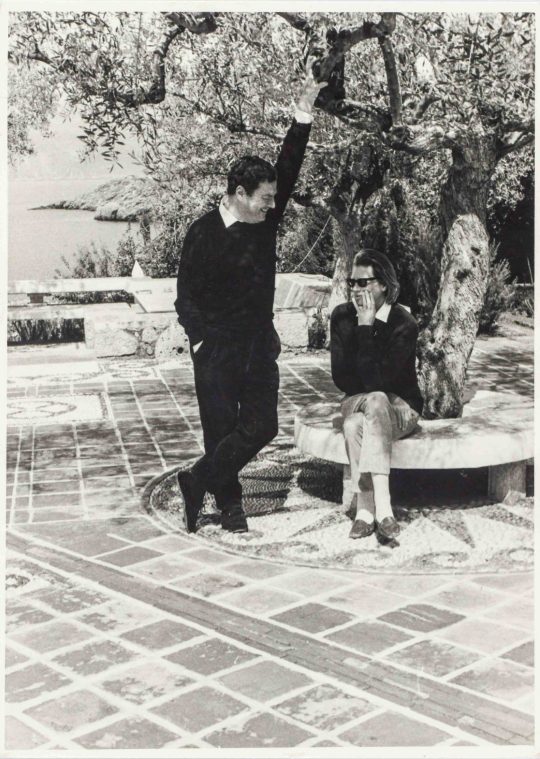
But some of Paddy’s life energy was sucked out of him when Joan died in Kardamyli in June 2003, aged 91. It was related that Joan said to her friend Olivia Stewart, who was visiting: 'I really would like to die but who'd look after Paddy?' Olivia said that she would. A few minutes later, Joan fell, hit her head - and died instantly of a brain haemorrhage. Joan had often quoted Rilke: 'The good marriage is one in which each appoints the other as guardian of his solitude.' Now Paddy Leigh Fermor was all alone.
Leigh Fermor was knighted in 2004, the day of his birthday which he delighted in like a giggling schoolboy. But he missed Joan terribly.
For the last few months of his life Leigh Fermor suffered from a cancerous tumour, and in early June 2011 he underwent a tracheotomy in Greece. As death was close, according to local Greek friends, he expressed a wish to visit England to bid goodbye to his friends, and then return to die in Kardamyli, though it is also stated that he actually wished to die in England and be buried next to his wife, Joan, in Dumbleton, Gloucestershire. He stayed on at Kardamyli until the 9th June 2011, when he left Greece for the last time. He died in England the following day, 10th June 2011, aged 96. It was reported that he had dined in full black tie on the evening of his death. Paddy had style even unto the end.
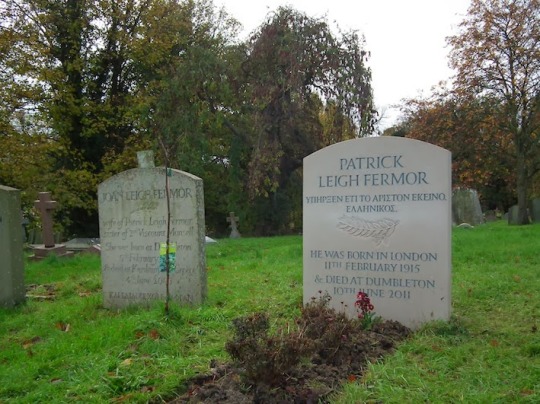
A Guard of Honour was formed by the Intelligence Corps and a bugler from his former regiment, the Irish Guards, delivered the ‘Last Post’ at Paddy’s funeral. As had been his wish, he was buried beside Joan. On his gravestone in Dumbleton cemetery is an inscription in Greek, a quote from Constantine Cavafy: “In addition, he was that best of all things, Hellenic.”
Although Joan had passed away at the age of ninety-one, after suffering a fall in the Mani. Her body was repatriated to Dumbleton, the place of her birth - ironic that her dream was to be as far as she could possibly go from the rolling humdrum Worcestershire hills. But perhaps she intended to return all along. When Paddy was buried beside her it seemed that the ‘pact of liberty’ that these two lonely souls had forged themselves could be tested in the great elsewhere. Joan was more than his muse (as many of her obituaries were at pains to declare) but his greatest adventure.
To come around full circle from the movie ‘Ill Met By Moonlight’ (1957) that I saw that night in Verbier, my father told me that rather poignantly, General Kreipe, the German commander Leigh Fermor had captured - once an enemy, and later a friend - left behind notes and photographs from across his life. On one of those notes, it was discovered, the following was scribbled from a brief visit to Greece: “Somewhere, amidst all the disarray, was the story of Joan and Paddy, and” it concluded, “…of their lives together.”
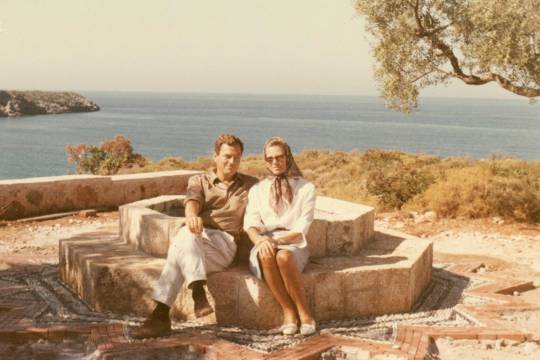
His life with Joan and all that she meant to him was one part of the mosaic of who Paddy Leigh Fermor was. But it’s incomplete.
Paddy didn’t like the idea of a biography, and neither did Joan when she was alive. But friends had persuaded them that unless Paddy appointed someone to write his life, he might find himself the subject of a book whether he liked it or not. In Artemis Cooper they couldn’t have chosen a better writer to chronicle Paddy’s life as a man of action and letters. Cooper, was the daughter of another accomplished diplomat and historian, John Julius Norwich, and grand-daughter of Duff and Diana Cooper. As the wife of the historian Antony Beevor, she became a trusted friend of the Leigh Fermors. Cooper was too good of a historian to let her friendship lead her astray from being a faithful but serious biographer. Knowing this, she was told she could go ahead, but she had to promise not to publish anything until after they were both dead.
Paddy did not like being interviewed, and would keep her questions at bay with a torrent of dazzling conversation. He was the master at deflecting discussions away from himself.
He was also very unwilling to let Cooper see many of his papers, though the refusal always couched in excuses. ‘Oh dear, the Diary…’ It was the only surviving one from his great walk across Europe, and I was aching to read it. ‘Well it’s in constant use, you see, as I plug away at Vol III,’ he would say. Or, ‘My mother’s letters? Ah yes, why not. But it’s too awful, I simply cannot remember where they’ve got to…’ It was quite obvious that he and Joan, while being unfailingly generous, welcoming and hospitable, were determined to reveal as little as possible of their private lives.
While they were more than happy to talk about books, travels, friends, Crete, Greece, the war, anything - they would not tell her any more than they would have told the average journalist. But she persisted and got closer than most. He showed particularly gallantry in not talking about his romantic entanglements. But she soon twigged that anytime he described a woman as ‘an old pal’ it was a sure bet that he had an affair with her.
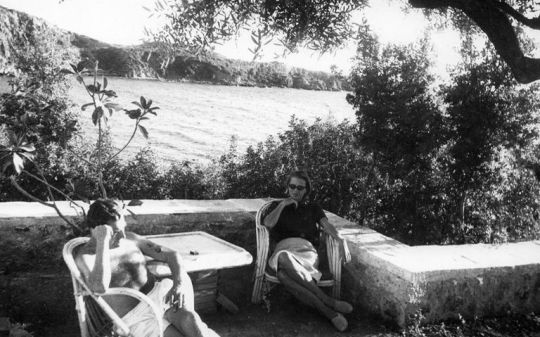
Intriguingly, Paddy liked to claim he was descended from Counts of the Holy Roman Empire, who came to Austria from Sligo. Paddy could recite ‘The Dead at Clomacnoise’ (in translation) and perhaps did so during a handful of flying visits to Ireland in the 1950s and 1960s, partying hard at Luggala House or Lismore Castle, or making friends with Patrick Kavanagh and Sean O’Faolain in Dublin pubs. He once provoked a massive brawl at the Kildare Hunt Ball, and was rescued from a true pounding by Ricki Huston, a beautiful Italian-American dancer, John Huston’s fourth wife and Paddy’s lover not long afterwards.
And yet, a note of caution about Paddy’s Irish roots is sounded by his biographer, Artemis Cooper, who also co-edited ‘The Broken Road’, the final, posthumously published instalment of the trilogy. “I’m not a great believer in his Irish roots,” she said of Leigh Fermor in an interview, “His mother, who was a compulsive fantasist, liked to think that her family was related to the Viscount Taaffes, of Ballymote. Her father was apparently born in County Cork. But she was never what you might call a reliable witness. She was an extraordinary person, though. Imaginative, impulsive, impossible - just the way the Irish are supposed to be, come to think of it. She was also one of those sad women, who grew up at the turn of the last century, who never found an outlet for their talents and energies, nor the right man, come to that. All she had was Paddy, and she didn’t get much of him.”
And I think that’s the point, no one really got much of Paddy Leigh Fermor even as he only gave a crumb of himself to others but still most felt grateful that it was enough to fill one’s belly and still feel overfed by him.
Paddy never tried to get to the bottom of his Irish ancestry, afraid, no doubt, of disturbing the bloom that had grown on history and his past, a recurring trait. “His memory was extraordinary,” Artemis Cooper noted, “but it lay dangerously close to his imagination and it was a very porous border.”
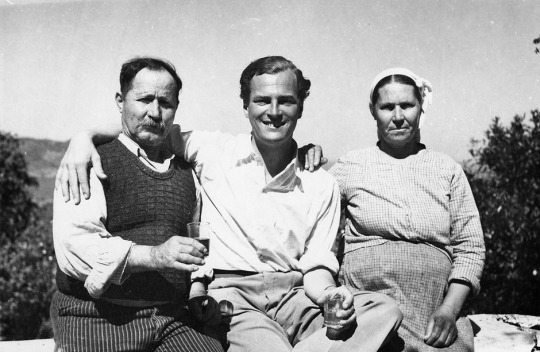
Within the Greek imagination many Greeks saw in Paddy Leigh Fermor as the second coming of Lord Byron. It’s not a bad comparison.
Lord Byron claimed that swimming the Hellespont was his greatest achievement. 174 years or so later, another English writer, Patrick Leigh Fermor - also, like Byron, revered by many Greeks for his part in a war of liberation - repeated the feat. Leigh Fermor, however, was 69 when he did it and continued to do it into his 80s. Byron was a mere 22 years old lad. The Hellespont swim, with its mix of literature, adventure, travel, bravery, eccentricity and romance, is an apt metaphor for Leigh Fermor’s life. Paddy Leigh Fermor was the Byron of his time. Both men had an idealised vision of Greece, were scholars and men of action, could endure harsh conditions, fought for Greek freedom, were recklessly courageous, liked to dress up and displayed a panache that impressed their Greek comrades. Like a good magician it was also a way to misdirect and conceal one’s true self.
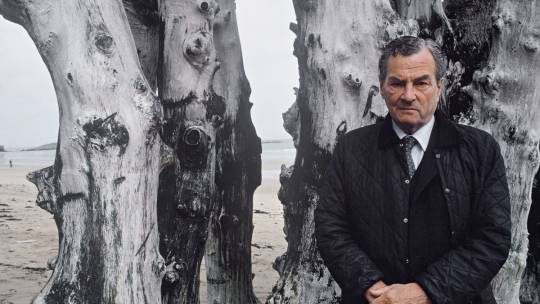
What or who was the true Paddy Leigh Fermor?
Like Byron, Leigh Fermor appeared as a charismatic and assured figure. He was a sightseer, consuming travel, culture, and history for pleasure. He was an aristocrat moving in the social circles of his time. He was a gifted amateur scholar, speculating on literary and historical sources. Leigh Fermor, Byron’s own identity, is subject to textual distortion; it emerges from a piece of occasional prose in his books and is shaped by the claims of correspondence on a peculiarly fluid consciousness.
There is no hard and fast distinction to be drawn here between real and imagined, only a continuity of relative fictions that lie between memory and imagination as his biographer asserted. If there is a will to assert identity here, to disentangle fact and fiction, to give things as they really are and nail down the real Leigh Fermor then it is somewhere between the two. This is where we will find Paddy.
For many his death marked the passing of an extraordinary man: soldier, writer, adventurer, a charmer, a gallant romantic. As a writer he discovered a knack for drawing people out and for stringing history, language, and observation into narrative, and his timing was perfect. Paddy often indulged in florid displays of classical erudition. His learned digressions and serpentine style, his mannered mandarin gestures, even baroque prose, which Lawrence Durrell called truffled and dense with plumage, were influenced by the work of Charles Doughty and T.E. Lawrence. But one can’t compare him. I agree with the acclaimed writer Colin Thurbon who said, “There is, in the end, nobody like him. A famous raconteur and polymath. Generous, life-loving and good-hearted to a fault. Enormously good company, but touched by well-camouflaged insecurities. I would rank him very highly. ‘The finest travel writer of his generation’ is a fair assessment.”
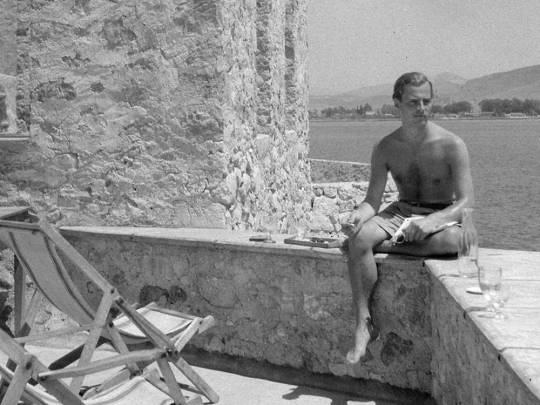
As a child I didn’t really know who Paddy Leigh Fermor was other than this very cheerful and charismatic old man was kind, attentive, and took a boyish delight in everything you were doing. Only later on in adulthood was it clear to that Paddy was not only among the outstanding writers of his time but one of its most remarkable characters, a perfect hybrid of the man of action and the man of letters. Equally comfortable with princes and peasants, in caves or châteaux, he had amassed an enviable rich experience of places and people. “Quite the most enchanting maniac I’ve ever met,” pronounced Lawrence Durrell, and nearly everyone who’d crossed paths with him had, it seemed, come away similarly dazzled.
I am equally dazzled - more smitten in retrospect - for alas they don’t make men like Paddy any more. But every time I dip back into his books I think I discover a little bit more of who Paddy Leigh Fermor was because I find him some where between my memory and my imagination.
#essay#paddy leigh fermor#leigh fermor#joan raynor#joan leigh fermor#greece#crete#second world war#SOE#war#british army#history#general kreipe#stanley moss#literature#author#writer#travel#explorer#wanderlust#travel writing#europe#mani#peloponnese#kardamlyi#lord byron#ill met by moonmight#film#movie#personal
128 notes
·
View notes
Text

Cretan Resistance Fighters WWII.
When NAZI airborne forces invaded the island of Crete in May of 1941 they were met in part by unexpectedly strong resistance from civilian men, women, and in some cases children. Sadly, privately owned firearms were rare on the island so the people fought the vaunted Fallschirmjagers with clubs, farm implements and bare hands. In one case a farmer well into his 70s strangled a German troop with his work strengthened hands. Those who knew how to use them turned the captured NAZI weapons on the invaders fighting until overwhelmed by numbers.
Even after occupation the people of Crete continued to oppose the NAZIs by forming an underground. Originally self equipped with captured weapons the resistance was eventually supported by the Allies through the SOE/OSS.
27 notes
·
View notes
Text
taxi from spili to minoan monastiraki: 31.50€
entrance ticket: 3€
getting to take pictures of the site that even minoancrete.com doesn't have, meeting the rethymno ephorate of antiquities while she and her people are going around the site discussing how to make it better accessible for people: priceless
i'm probably going to be remembered by that taxi driver as an insane person because with the way the buses are set up there was no way for me to get there without having to stay overnight and there was nowhere coming up to stay, so i'm in agia galini, got the bus to spili, and then got the only taxi in that village to drive me to monastiraki, which confused everyone at first because the monastiraki that most people know about is in athens. it's a major tourist attraction! but crete monastiraki is just beyond amari, and it took a moment for this to get figured out.
then i followed the signs. and got lost. then i flagged down a car to ask for directions and the driver was going to the site, because he was helping the ephorate of antiquities and her assistant (??) with deciding how to lay down pathways and make the site more accessible because, let me tell you, there are about three actual pathways laid out and everything else is tramping through long grass.
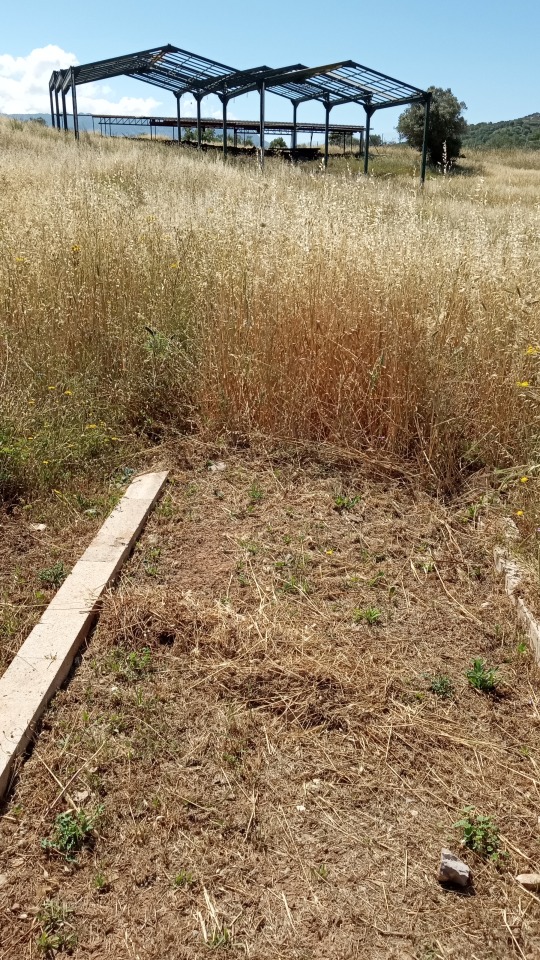
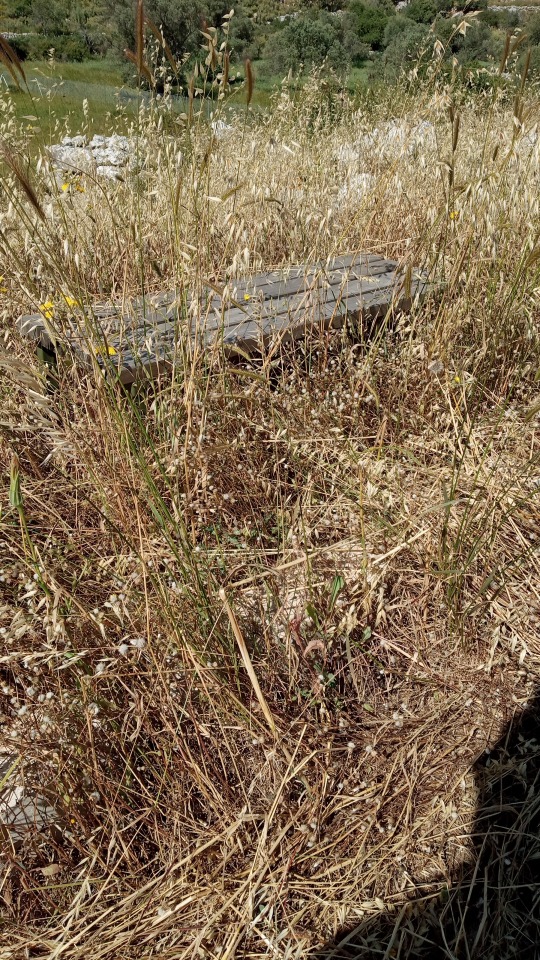
one of the paths just. stops. and these? the left part is the central court, covered in grass and flowers and everything.


the modern history of the site itself is very interesting considering that john pendlebury (one of my personal heroes, move aside indiana jones) was the first one to start excavating. the nazis took over looking at the site during their occupation of crete, working off of pendlebury's notes since they executed him when he refused to answer any of their questions (he was the leader of the british part of the cretan resistance. the nazis called him 'lawrence of crete' after lawrence of arabia).
this site was also excavated by athanasia kanta (also one of my heroes! she who is in charge of the knossos-anetaki dig, my beloved), and there's a nice portion of it beneath some coverings that i needed to rest under after being very careful not to turn any of my ankles.

i have a problem and it is my addiction to the 'panorama' function on my camera. also how my tumblr is now in portuguese.
29 notes
·
View notes
Text
Yagstong
Because I 100% know what animal the Yagstong is, I decided to reference grazing animals that are as unlike That Real Beast as possible. I settled on the pika and the giant panda.

This male yagstong and his lusty nature cannot be contained, only censored. These entries keep bringing up behaviors I will not draw without cash exchanging hands, god damn.

This yagstong has found some dittany for its ills :) ... but apparently I picked the wrong plant with the common name dittany to reference, because Dictamnus albus, aka dittany/burning bush/gas plant/fraxinella, is mildly toxic and has volatile oils. Origanum dictamnus, aka dittany of Crete/Cretan dittany/hop marjoram, on the other hand, smells nice and was believed in antiquity to be healthful. Also its wiki page references The Actual Beast. This is what happens when you just look at the pictures and don't scroll down; you give your yagstong poison resistance. Good for them, good for them.
Dictamnus albus apparently grows 1'4"-3'3" (40-100 cm) high, so based on the proportions in my second picture my yagstong is in the middle between a pika (about 6-9 inches or 15-23 cm long), and a giant panda (3'11"-6'3" or 1.2-1.9 m long).
#yagstong#maniculum bestiaryposting#artist: me :)#I feel like they ended up a little Hamtaro-esque#the roundest beasts
6 notes
·
View notes
Text
Greek Mythology Crawl
By: emilytruelove226
(saving-word-crawls note: This has multiple different challenges in it! Take whichever you please :) )
The Labours of Heracles Challenge
Completing any three of these challenges is enough to make you a true hero, so pick wisely and play to your strengths. However, if you’re looking for a Herculean challenge, try to finish all twelve!
To defeat the Nemean Lion, which cannot be injured by any weapon, you’ll need stamina. Write for 20 minutes without stopping.
To slay the Hydra, you’ll have to complete a 50-headed hydra challenge.
To capture the Golden Deer sacred to Artemis, you’ll have to be fast. Write 600 words in 15 minutes. (600 words)
To capture the Erymanthian Boar, you need to build a sturdy trap. Writing 750 words ought to do it.
To clean the Augean stables in a single day, flood them by writing 500 words as quickly as you can!
Scare away the Stymphalian Birds by writing a scene in which someone or something makes a loud noise.
Wrestle the Cretan Bull to the ground by writing 400 words in 10 minutes or less.
Steal away the Mares of Diomedes with a 30 minute sprint.
To impress Hippolyta, Queen of the Amazons, into giving you her girdle, write a scene which develops one of your female characters.
To defeat the three-headed giant Geryon, write 333 words in 10 minutes or less.
Try to convince Atlas to help you steal the apples of the Hesperides by completing a 15 minute sprint. If you manage more than 500 words, you succeed.
Descend to the Underworld to capture the three-headed dog Cerberus by writing for 15 minutes with your eyes closed.
The Iliad Challenge
Eris causes trouble with a golden apple. Write 100 words while everyone gossips about who “For The Fairest” means.
Paris is trying to choose which goddess most deserves the Golden Apple. Convince him by writing for 10 minutes. If you don’t manage at least 300 words, you’ll have to bribe him with another 150.
Paris meets Helen, and they run away together to Troy. Sprint for 10 minutes while you flee Menelaus!
Menelaus gathers an army – convince them to fight on your side by writing 250 words as fast as you can.
The Greeks lay siege for 10 long years, so sprint for 10 minutes while the war drags on.
Inside the wall, Cassandra warns Troy of imminent danger. Write 100 words while everyone ignores her prophecies.
Paris shoots Achilles in the heel, and he dies. Take a break while Trojans celebrate and Greeks mourn.
Finally, the Greeks claim victory with their wooden horse. Write 500 words as quickly as possible to sneak inside the city and win the war!
The Odyssey Challenge
It’s stormy sailing as Odysseus tries to return home. Wrestle with the weather for 200 words as you get blown further and further off course.
You arrive at the island of the Cyclops. In order to talk your way out of trouble, write 300 words in 10 minutes or less. If you fail, fight your way out with another 200 words.
You land yourself in trouble on the island of the cannibal Laestrygonians. Sprint for 150 words back to your ship.
Hold your nerve as you sail between the monster Scylla and the whirlpool Charybdis. Write for 10 minutes without stopping as you carefully make your way between the two.
You reach the Isle of the Lotus Eaters. Take a break, but don’t stay too long – you might not want to leave!
You order your men to stuff their ears as you sail past the seductive sirens. Write for 10 minutes with your eyes closed, and resist the temptation to peek!
The sorceress Circe captures your men and turns them into pigs! Fight her off with a 200 word sprint.
Calypso keeps you captive on her island for seven years. Sprint for seven minutes as you wait for her to let you return home.
You arrive home to find your wife Penelope beset by unwanted suitors. Prove to them that you’re the fabled Odysseus by showing them how fast you can sprint 250 words.
Hades and Persephone Challenge
Frolic in the meadows with Persephone and the nymphs by writing a relaxed 150 words without timing yourself.
Hades snatches Persephone and descends with her into the Underworld. Race after them by writing for a 15 minute sprint.
Demeter gives Zeus the sharp edge of her tongue! Write 300 words. If you manage it in 10 minutes or less, you’ve convinced Zeus to talk to Hades on your behalf. If you take more than 10 minutes, you’ll have to persuade him further by writing another 200 words.
Hades and Persephone get to know each other in the Underworld. See how fast you can write 250 words while they fall in love.
Meanwhile, Demeter has cast the whole world into a dark and dismal winter! Write for 10 minutes with your eyes closed as the crops fail and the land is covered in snow.
Persephone swallows six pomegranate seeds and had to spend six months of the year in the Underground – so you’d better sprint for 6 minutes!
To celebrate Persephone’s crowning as Queen of the Underworld, show off how fast you can sprint 200 words.
#variable#variable length crawl#medium#medium crawls#word crawls#word crawl#greek mythology#greek mythology crawl#greek myth
0 notes
Text
Experience the Unseen: Rethymno, Crete's Best-Kept Secrets
Nestled on the northern coast of Crete, Rethymno is a picturesque town that seamlessly blends history, culture, and natural beauty. While many travelers flock to popular destinations like Chania and Heraklion, Rethymno offers unique charm and hidden gems waiting to be discovered. This article will take you through Rethymno's best-kept secrets, from its quaint corners to its stunning natural landscapes.
The Venetian Harbor
One of Rethymno's most iconic features is its Venetian Harbor. While it might not be a secret to all, this charming waterfront area offers more than just scenic views. Early morning strolls along the harbor allow visitors to witness local fishermen at work and experience the serene atmosphere before the crowds arrive. The harbor is lined with traditional tavernas where you can enjoy fresh seafood with a view of the moored boats and the ancient lighthouse.

Archaeological Museum of Rethymno
Often overshadowed by its more famous counterparts, the Archaeological Museum of Rethymno is a hidden treasure that showcases the region's rich history. Housed in a 19th-century building, once a Venetian monastery, the museum features an impressive collection of artifacts from the Minoan, Roman, and Byzantine periods. Exhibits include ancient pottery, sculptures, and jewelry, providing a comprehensive overview of Crete's past.
The Old Town’s Secret Alleys
Rethymno’s Old Town is a labyrinth of narrow streets and alleys that offer a glimpse into the past. While the main squares and famous streets can be bustling, the authentic charm lies in exploring the lesser-known paths. Wander through these hidden alleys to discover charming cafes, artisan shops, and historical buildings. Venetian, Turkish, and Greek architecture mix creates a unique atmosphere perfect for leisurely exploration.
Preveli Beach
Preveli Beach, located about 35 kilometers south of Rethymno, is a natural paradise that remains relatively undiscovered by mass tourism. The beach is famous for its unique setting at the mouth of the Kourtaliotis River, which creates a lush palm forest that contrasts beautifully with the golden sand and turquoise sea. A walk through the palm forest to the beach offers a tranquil escape from the more crowded spots on the island.

Rethymno’s Hidden Villages
Visiting the surrounding villages is a must for those looking to experience authentic Cretan life. Places like Argyroupoli and Anogeia offer a glimpse into traditional Cretan culture. Argyroupoli is known for its beautiful springs and ancient Roman ruins, while Anogeia is renowned for its rich history and traditional weaving. These villages provide a slower pace of life and a chance to engage with locals in a way that more touristy areas cannot.
The Fortezza Castle
Perched on a hill overlooking Rethymno, the Fortezza Castle is an impressive fortress often overlooked by visitors who prefer the town’s more visible attractions. The castle dates back to the 16th century and offers stunning panoramic views of the town and the sea. Exploring its walls and bastions provides insight into the region's history and strategic significance. It’s an excellent spot for history enthusiasts and those seeking a quiet retreat with a view.

The Monastery of Arkadi
Located about 23 kilometers from Rethymno, the Monastery of Arkadi is a site of historical and spiritual significance. This 16th-century monastery is known for its role in the Cretan resistance against Ottoman rule. The architecture is a mix of Renaissance and Byzantine styles, and the site includes a small museum displaying artifacts from the monastery’s history. The serene setting and historical depth make it a meaningful visit.
The Hidden Gorges
Crete is renowned for its gorges, but Rethymno’s hidden gems include several lesser-known options. The Kourtaliotiko Gorge, for instance, is a dramatic and scenic location often bypassed by tourists. Its winding paths and rugged terrain make it a rewarding hike for those seeking solitude and natural beauty. Additionally, the Selinou Gorge provides a beautiful trail through diverse flora and stunning rock formations.
Conclusion
Rethymno is more than just a beautiful coastal town; it’s a destination rich with hidden treasures that offer a deeper understanding of Crete’s cultural and natural heritage. From the tranquil Preveli Beach and the charming Old Town alleys to the historic Fortezza Castle and the serene Monastery of Arkadi, Rethymno’s best-kept secrets invite travelers to explore beyond the surface. Embracing these lesser-known spots enriches your travel experience and connects you with Crete's authentic spirit.
FAQs
1. What is the best time to visit Rethymno?
The best time to visit Rethymno is from late spring to early autumn (May to October). The weather is warm and pleasant, ideal for exploring the town and its surrounding areas. Summer is peak tourist season, so visiting in late spring or early autumn can offer a more relaxed experience.
2. How do I get to Preveli Beach from Rethymno?
To reach Preveli Beach from Rethymno, you can drive south for about 35 kilometers. The journey takes approximately 45 minutes. Alternatively, local buses operate routes to the area, though schedules can vary. It’s advisable to check for bus timings in advance.
3. Are there guided tours available for the hidden villages around Rethymno?
Several local tour operators offer guided tours to the hidden villages around Rethymno. These tours often include transportation and a guide who provides insight into the history and culture of the areas visited. Booking in advance is recommended, especially during peak travel seasons.
4. Is the Fortezza Castle accessible for visitors with mobility issues?
Fortezza Castle has some areas accessible to visitors with mobility issues, but the terrain can be uneven and steep in parts. It’s advisable to contact the site in advance to inquire about accessibility options and any available assistance.
Website | Facebook | Instagram | Medium | Quora
0 notes
Text
Two stories of the Battle of Crete 1941: The Girl Under The Olive Tree, and Anzac Fury
I read three books concerning Crete this month. First, Swallows Dance by Wendy Orr, set in the Bronze Age. Then I read in tandem both a novel and a history on what happened from 1941 to 1945 to the Cretan population, and to others caught up in the invasion and occupation, including soldiers and resistance fighters of Crete, Greece, Italy, Germany, Britain, Australia and New Zealand (ANZACS). An…
View On WordPress
0 notes
Text
THE PURPOSE OF BEING APPOINTED TO LEAD THE PEOPLE OF GOD 2
[Let us study the epistle to Titus 2]
"FOR this reason I left you in Crete, that you should SET IN ORDER the things that are LACKING, And APPOINT ELDERS in every city as I commanded you."
Titus 1:5 (NKJV)
• Titus himself who was to appoint the elders had gotten to have a strong and steadfast believe in the teaching of the Word of God.
- When he does, he would be able to correct and put on the right path or track, those who's minds are warped and sold to the devil (2 Timothy 2:25,26).
- The responsibility, what a church leader is expected to do:
10 FOR there are many REBELLIOUS PEOPLE who engage in USELESS TALK and DECEIVE OTHERS. THIS is especially true of those who insist on circumcision for salvation. 11 THEY MUST BE SILENCED, BECAUSE they are TURNING whole families AWAY from the TRUTH by their FALSE TEACHING. AND THEY DO IT ONLY FOR MONEY" (Titus 1:10,11 NLT).
(i) Many rebel, resist and oppose the right Teaching, they would rather engage in the useless talking, and deceive the people; such should be silenced. (2 Timothy 4:3,4).
TALKING or teaching that is not consistent with the Bible, brings contradictory doctrine or teaching to the body of Christ (2 Timothy 2:16,23).
(ii) As a leader, you have a responsibility to silence them, And that could be done effectively, only If you as a leader did stand firm in the right teaching of the Word of God (Titus 1:10).
(iii) The deceivers. The teachers who are teaching wrong and erroneous doctrines had led many astray, away from the right path or direction, that is, from the truth (Titus 1:11; 1 Timothy 6:3-5; 2 Timothy 2:16-18; 3:5-7).
SUCH people, those who are heretic, do whatever they are doing for dishonest Gain, to get money from the people—their belly is their god (Titus 1:11; Philippians 3:18,19).
(iv) Work on the people given you by God, teaching them the True Word of God, to make them firm in the Christian Faith—through the teachings (Titus 1:13,14; 1 Timothy 4:13; 2 Peter 1:12,13).
a. Rebuke, reprove and correct with love when needed, that they might be strong in the Faith (Titus 1:13).
b. Tell them not to listen to those who have turned their backs against the truth (Titus 1:14; 2 Timothy 2:18).
c. They should stay away from those who claim to know God, but they deny Him in work and character—those who deny God through the way they live their lives (Titus 1:16; 2 Timothy 3:5,7).
• Note: In digression, Apostle Paul also mentioned that a negative trait could be peculiar to a people; a group, a tribe, or a race:
12 ONE of them, a prophet of their own, said, “CRETANS ARE ALWAYS LIARS, EVIL BEASTS, LAZY GLUTTONS.” 13 THIS TESTIMONY IS TRUE. Therefore REBUKE THEM SHARPLY, THAT they may be SOUND IN THE FAITH" (Titus 1:12,13 NKJV).
- If you are a Believer in Christ Jesus, any negative trait, or a peculiar negative character with your people; tribe, or whatever, should not be accepted by you As the Norm—because you are a Believer, a child of God.
- You work on it, that such a thing would not be found in your life, as a Believer.
a. Apostle Paul told Titus in the epistle that the Cretans are always liars, evil beasts, and lazy gluttons. And the testimony is true!
b. He said Titus should rebuke them sharply, that they may be sound in the Faith (Titus 1:12,13).
- Whatever negative trait found in your town or city, tribe, or your nation at large, should not be found in your life, or be emulated by you.
- Some who claimed to be Believers in Christ would even be boastful of such negative traits. I have heard someone said love of money is peculiar to his tribe. He was saying it boastfully with pride As If it was a good thing.
SOME would say Anger is peculiar to their family or tribe, or the people in the area or town they came from.
- A Believer should not be boastful of wrong Character traits found in their lineages, tribes, towns or cities, or the Nation.
- The Cretans were said to be liars, evil beasts, and lazy gluttons. Now, imagine a Cretan Believer boastfully saying; In my place, lying is part of our system, we lie at will, and we are tough; inclined to violent or disruptive behaviour, we behave like beasts, and we are gluttons and laid-back.
- If nonbelievers boastfully identify with such negative traits, a Believer should not. And If there are traces of such negative traits in your life and Character, as a Believer, you have to deal with them. Break the hold of such traits in your life.
- You should not say, that is the way I am, where I came from, we are like that. In fact, If you did not behave like that in my place, they would say you are a bastard, you are not the son of the soil—the aboriginal.
NO, It is wrong for a child of God, a Believer in Christ Jesus, to say such a thing—be boastful of wrong Character traits in his or her lineage, tribe, town or city, and whatever.
• Titus was also admonished:
"NOT giving heed to JEWISH FABLES and COMMANDMENTS OF MEN who TURN from the TRUTH" (Titus 1:14 (NKJV).
- We are at the perilous times, the time which the Bible says people would not endure sound doctrine (2 Timothy 4:3).
- The time when people would depart from the faith, or the truth of the Scripture, and give heed to the deceiving spirits, and the doctrines of demons (1 Timothy 4:1,2).
- The last days, the perilous times, when people would be lovers of themselves, lovers of money; when they would be boasters, blasphemers, unholy, and whatever (2 Timothy 3:1-4).
- Such people, Believers, are found in the church now. They are: "HAVING A FORM OF GODLINESS BUT DENYING ITS POWER. And FROM such people TURN AWAY!" (2 Timothy 3:5 NKJV).
- Now, no matter the pollution in the world, and in the church, Apostle Paul said:
15 TO THE PURE ALL THINGS ARE PURE, BUT to those WHO are DEFILED and UNBELIEVING NOTHING IS PURE; BUT even their MIND and CONSCIENCE are DEFILED. 16 THEY PROFESS TO KNOW GOD, BUT IN WORKS THEY DENY HIM, being abominable [detestable], disobedient, and disqualified for every good work" (Titus 1:15,16 NKJV).
- In other words, those who are pure and hold on to the truth of the Scripture, would abide and live by the truth of the Scripture. While those who's minds are polluted or defiled would want to go in their own way.
- Such people, the so-called Believers who's minds are not pure or defiled, professed to know God, but through their fruits, one would know they are not genuine. Through their works, one would know they are not of God.
- Such are the ones who disagree with a part of the Bible, and twist the Scriptures to suit their Purposes:
"SPEAKING of these things in all of his [Paul's] letters. Some of his comments are hard to understand, And THOSE WHO ARE IGNORANT AND UNSTABLE HAVE TWISTED HIS LETTERS TO MEAN SOMETHING QUITE DIFFERENT, JUST AS THEY DO WITH OTHER PARTS OF SCRIPTURE. And THIS WILL RESULT IN THEIR DESTRUCTION" (2 Peter 3:16 NLT).
- As a Believer who has heaven as his or her goal, you should be wary of those who go about with heretic teachings; those who twist the Scriptures to suit themselves.
- These people have turned from the truth, they are of corrupt minds and they are destitute or completely lacking the Truth; And the Bible says, you should turn away, or depart, from them:
"THESE ARGUERS—THEIR MINDS WARPED BY SIN—DON'T know how to TELL THE TRUTH; TO them the Good News is just A MEANS OF MAKING MONEY. KEEP AWAY FROM THEM" (1 Timothy 6:5 the Living Bible).
• You will not fail in Jesus' name.
- Should there be any ailment in your body, receive your healing now in Jesus' name.
- Hold of infirmity on your life is broken now in Jesus' name.
Peace.
#christianity#gospel#christian blog#jesus#devotion#my writing#prayer#faith#christian living#the bible
0 notes
Photo


The Forgotten Palace by Alexandra Walsh
In an underground labyrinth a lost soul wanders, waiting for revenge, waiting for love…
London 1900 Alice Webster has made the worst decision of her life. When her Aunt Agatha offers her the chance to go on a Grand Tour she jumps at the opportunity to get away from the glare of scandal. Heading off to see the world as the century turns, Alice begins to believe her broken heart can be healed, and a chance encounter on a train bound for Paris changes everything. When their journey takes them to a Cretan house thick with history, and the world-famous dig at Knossos, stories from the past begin to echo through Alice’s life.
London Present Day Eloise De’Ath is meant to be a grieving widow. But if people knew the truth about her late husband, they’d understand why she can’t even pretend. Needing to escape, Eloise heads to Crete and the house her father-in-law Quinn left her, and slowly Quinn’s home begins to reveal its mysteries. In his office Eloise discovers his life’s work: the study of the Victorian excavation to find the Minotaur’s labyrinth. Fascinated by the diaries of a young woman from the dig, Eloise is drawn into Alice’s tale of lost love and her growing obsession with Ariadne, the princess of the labyrinth.
Three women divided by time but connected by the long-hidden secrets of the past. As their stories join in a golden thread, a terrible injustice might finally be undone…
Purchase Link - https://amzn.to/3kbJCiI
My Review: Long time ago I fell in love with the Prince of the Lilies and I was fascinated when I saw Cretean objects at the Ashmolean Museum. My love for this mysterious civilisation was the reason I asked to join this blog tour and I wasn't disappointed. Myth, past and present: three women and three different stories mixed with historical facts and characters. Ariadne, Alice, and Eloise: the myth, the past and the present. It was a riveting read and I learned something more about Evans and even about the Minoans' myths. The author did an excellent job in researching and bringing back the past and the age of Evan excavation. Alice is a well-rounded character and I liked her story and her evolution. Eloise is the present: a story of a woman who suffered abuse but who was also able to be resist and start a trip of changes and discovery. Ariadne is the myst and the most intriguing character. A well plotted and tightly knitted story that I read in two sitting. Loved these characters Highly recommended. Many thanks to Boldwood Books and Rachel's Random Resources for this arc, all opinions are mine
The Author: Alexandra Walsh is the bestselling author of dual timeline historical mysteries, previously published by Sapere. Her books range from the fifteenth century to the Victorian era and are inspired by the hidden voices of women that have been lost over the centuries. Formerly a journalist, writing for national newspapers, magazines, and TV, her first book for Boldwood will be published in Spring 2023.
Social Media Links: Facebook: https://www.facebook.com/themarquesshousetrilogy Twitter: https://twitter.com/purplemermaid25 Instagram: https://www.instagram.com/purplemermaid25/ Bookbub profile: https://www.bookbub.com/authors/alexandra-walsh
#historical fiction#women's fiction#Boldwood Books#Rachel's Random Resources#blogtour#NetGalley#review
0 notes
Text
Having no defense and knowing it, Antilochus grimaced and first said nothing. That was the easiest way out, even if Idomeneus wasn't at all as talkative - or rather, long-winded - as his father. Apparently not all men grew a forest of words and took a long stroll through it nearly every time they opened their mouth as they aged.
(He loved his father. He even liked most of his stories, and more so how his father told them, which made them fun to listen to again and again, but ah. Sometimes...)
"Patroclus seems to be doing fine," Antilochus muttered, then rallied.
Twisting around so he was facing Idomeneus more than Achilles and Patroclus, he peered up at the Cretan king. Strangely he found himself a little more relaxed, despite having just been embarrassed, than when Thrasymedes had caught him out. Maybe it was just because he barely knew the king of Crete, and though he might see him often enough, he wasn't as familiar a face as some of the men in the Pylian contingent was starting to become.
"Does shooting down such an easy target honour you?" No longer upset enough to actually pout - besides he was trying to behave more gracefully, even if it sometimes was still very useful to just behave as he usually did with his older brothers even among these great kings and princes - Antilochus just shook his head. "Besides, that sounded like you were talking with experience? Would it be so bad? I wasn't even thinking about... uh. Love."
Shifting in his seat and lowering his voice, Antilochus shrugged again. Managed to resist looking over his shoulder, this time. If either of them - but especially Achilles - just looked at him with half the attention they seemed to have taken up in his head he might be happy with that.
@fadedpath asked: You’ll think it’s love, while he dines on your heart. ( gonna try something here…. idomeneus to antilochus )
-
Lurching upright in his seat as if stung, Antilochus sputtered for a moment or two, cheeks burning.
"W-who said anything about love?"
He was not going to look back in the direction he'd been staring in. And it had been staring, he knew. He was not.
A twitch in the corner of his eye gave him the bare glance of blond and brown hair, almost intermingling, where Achilles and Patroclus were leaned towards each other in conversation.
Well. Failed that.
Wilting under Idomeneus' stare, Antilochus cleared his throat. He wasn't yet sure if this was worse than when Thrasymedes had caught him staring, too, or not.
"What, uh--- what do you even mean, sir?"
The wide-eyed bafflement was as much a hopeless but hopeful smokescreen as it was earnest. Idomeneus' statement was mystifying, and in that moment, aside from marinating in his embarrassment, Antilochus felt every one of his comparatively few years.
7 notes
·
View notes
Photo

Partisans crétois après l'invasion allemande - Bataille de Crète - 1941
#WWII#Campagne des Balkans#balkans campaign#bataille de crète#battle of crete#Résistance#résistance crétoise#cretan resistance#Partisans#Crète#crete#Grèce#greece#1941
44 notes
·
View notes
Text


To Have and To Lose, by Reg Spurr
20 notes
·
View notes
Text
SOE Greek Section: The capture of General Heinrich Kreipe in German Occupied Crete 1944.
Members of the Cretan Resistance. Top photograph SOE agents Fermor and Moss dressed as German soldiers. Leigh ‘Paddy’ Fermor served with the Irish Guards but due to his knowledge of modern Greek history he soon came to the attention of the Greek Section of the Special Operations Executive (SOE). He fought in Crete and mainland Greece during the German occupation and infiltrated Crete three times…

View On WordPress
#Alan Malcher Military Historian#Bill Stanley SOE#Cretan Resistance#General Kreipe#Greek Resistance#Leigh Fermor SOE#SOE#SOE Greece
0 notes
Photo
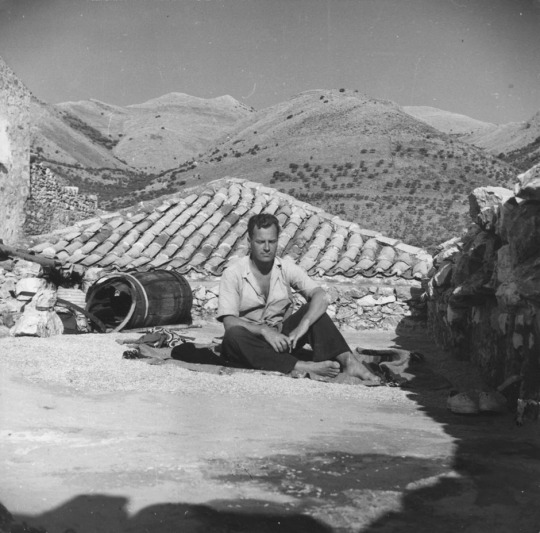
Like Venice, Château d'Yquem or a Rolls-Royce of the 1930s, he really was beyond competition.
- Jan Morris on Sir Patrick Leigh Fermor DSO
In 1933, at a mere 18 years old, Paddy Fermor decided to walk from Holland to Turkey and thus began his journey to literary fame and distinction as one of the 20th Century’s best travel and prose stylist.
His personality united not only scholar and daredevil - following in the spiritual footsteps of Victorian explorers such as Livingstone, Speke, and Burton - but also different periods of British history. As the tough, courageous commando who led the Cretan resistance and spirited a German general from Crete to Egypt during World War II, he operated in gritty, twentieth-century T. E. Lawrence-Ian Fleming terrain. And as a lifelong lover and scholar of Greek culture and language he inherited the mantle of Lord Byron, the Greeks' favourite Brit, after whom it seems that every town square in Greece is named.
Paddy was the architect of his own learning; his higher education was life itself. His own formal education came to an abrupt end when he managed to get thrown out of The King's School in Canterbury for publicly displaying affection for a local merchant's daughter, as well as for generally exhibiting, in the words of his headmaster, “a dangerous mixture of sophistication and recklessness."
This was an ideal formula for thriving in the high society of interwar London, evoked in the novels of writers such as Evelyn Waugh and Ronald Firbank. But Paddy, who had profound but vague ambitions, needed more than casual affairs and drunken orgies. He languished, a hungover and idle would-be writer, vaguely hoping to hit on something to write about, until inspiration struck: he would walk across Europe. It would be an adventure, a distraction, and useful research, all at once.
His parents financed the travels, mailing pound notes in envelopes to post offices and postes restantes across Central Europe from Holland to Bulgaria (not a single one was ever lost or missing). His walk became the stuff of legend. Paddy's gap year was the first year of the Nazis and the last of the gnarled, romantic old Germany whose spirit still lingered in the late middle ages. A Time of Gifts (1977) and Between the Woods and the Water (1985) were instant classics, celebrated for their evocation of a Central European world that had utterly vanished and their baroque language.
#jan morris#morris#quote#paddy leigh fermor#leigh fermor#patricl leigh fermor#english#travel#traveller#explorer#writer#europe#greece
39 notes
·
View notes